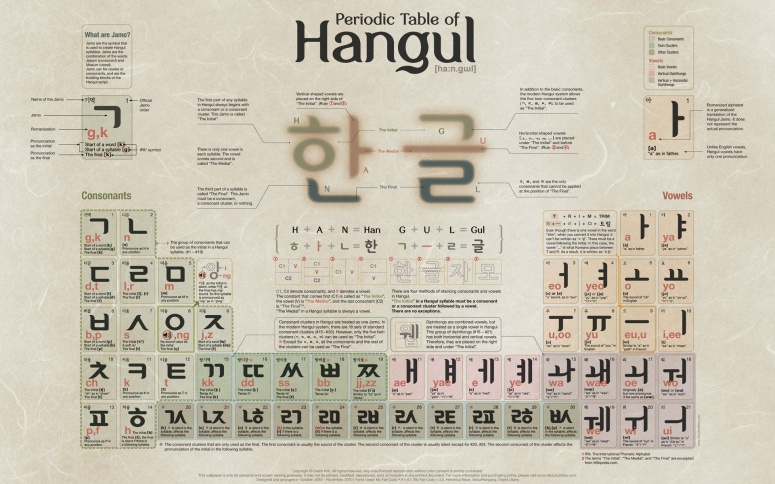KORE3
Section outline
-
-
By the end of the 10 weeks you will be able to:
· Articulate the origins of Hangeul (the when, why and by whom),
· Recognize, pronounce and write the Korean alphabet,
· Read and understand a selection of ‘loanwords’,
· Have the ability to pronounce many Korean words,
· Speak some basic greetings,
· Understand and sing a famous Korean song,
· Be aware of some basic aspects of Korean culture.
-
-
"If the people prosper, how can the king not prosper with them? And if the people do not prosper, how may the king prosper without them?" King Sejong.
-
King Sejong is best remembered for the invention of hangul, the Korean alphabet. In 1443, Sejong and eight advisers developed an alphabetic system to accurately represent Korean language sounds and sentence structure. They came up with a simple system of 14 consonants and 10 vowels, which can be arranged in clusters to create all of the sounds in spoken Korean.
King Sejong announced the creation of this alphabet in 1446 and encouraged all of his subjects to learn and use it:
The sounds of our language differ from those of Chinese and are not easily communicated by using Chinese graphs. Many among the ignorant, therefore, though they wish to express their sentiments in writing, have been unable to communicate. Considering this situation with compassion, I have newly devised twenty-eight letters. I wish only that the people will learn them easily and use them conveniently in their daily life.
Initially, King Sejong faced a backlash from the scholar elite, who felt the new system was vulgar (and who likely did not want women and peasants to be literate). However, hangul quickly spread among segments of the population that previously did not have access to enough education to learn the complicated Chinese writing system.
Early texts claim that a clever person can learn Hangul in a few hours, while someone with a lower IQ can master it in 10 days. It is certainly one of the most logical and straightforward writing systems on Earth—a true gift from King Sejong to his subjects and their descendants, down to the present day.
-
First 6 korean vowels worksheet
-
Korean Notes (You might like to write these into an exercise book)Lesson 11.Korean is spoken by 67 million native speakers on the Korean Peninsular and about 6 million speakers outside of Korea.2.Hangul is the name for the Korean alphabet and means ‘The Great Writing.’ It was invented in 1443 by King Sejong.3.All Korean characters can be drawn using 5 basic lines. ㅇ,ㄱ, ㅡ, ㄴ, ㅣ4.Korean letters are written from left to right and from top to bottom.5.Hangul is called an ‘alphabet syllabary’, because it combines the features of alphabetic and syllabic writing systems. That is it shows not just the individual phonemes but also how they are arranged into syllables. It is a 2-D writing system.6.Korean has 19 consonants and 21 vowels. (Don’t be put off English has at least 44 in total.) Your first job is to memorize these, …like crazy!!
-
-
IPA charts showing sounds of English and those sounds Korean doesnt have.
-
Crossword to revise the first 6 basic vowels
-
Lesson 2Notes (Please write into your exercise book)1.The consonants are modelled on the position of the mouth for that sound but,2.The vowels are modelled on an East Asian philosophy including Yin & Yang and the triad of Heaven (sun: circle) Earth (flat line) and man (vertical line).3.If the sun is to the right of the man and above the earth it makes a bright (yang) vowel. Eg ㅏ, ㅗ .4.If the sun is to the left of the man and under the earth it makes a dark (yin) vowel. ㅓ, ㅜ5.There are also neutral vowels, e.g. ㅣ, ㅡ.
-
-
-
Hey why not make your own google slides show for learning the consonants. Im sure yours will be better than mine. Search the internet for some great images. Then use art or draw to put the consonants over the top.
-
KOREAN CONSONANT CHARACTERS FOR PLAYING CARDS glue them onto card and make your own set.
-
Korean consonant writing practice worksheet
-
korean consonant construction order of strokes
-
Week 3
1. Korean words and sentences follow a CVCVCV…pattern.
English however allows consonant clusters to exist like CCCVCV and many variations thereof.
2. English can use one letter to make a word eg. 'a' but this can never happen in Korean. In Korean one letter does not a sound/word or syllable make. one needs 2 letters minimum to make a sound.
3. The word ‘strike’ is 1 syllable in English but 5 syllables in Korean, si-ti-ra-i-ki
4. Korean words are made up of syllable blocks. Each block must start with a consonant and each block can have one and only one vowel in it.
5. In Korean there are 3 families of vowels. The tall-ies, the flat-ies, and the angle-ies.
6. The angle vowels are created by combining a specific single flat vowel with a specific tall vowel. Done in accordance with the Vowel Harmony Principle (bright vowels go with bright vowels and dark goes with dark).
-
-
-
Korean Consonant poster for kiwis
-
Own very own class slideshow of korean consonants.
-




:max_bytes(150000):strip_icc():format(webp)/GettyImages-905757628-5c42a48e46e0fb0001369263.jpg)

